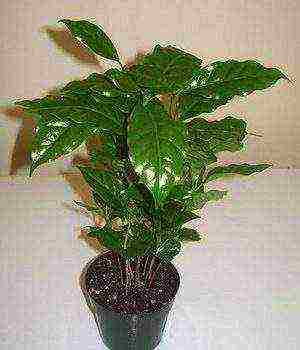Content [show]
Crossandra is a flower bright as fireworks, it stands out among the plants that are native to the tropics. He always attracts the attention of flower growers and deserves their love almost from the first minute. If there are already plants in the house that need warmth and humidity for normal life, the crossandra can be safely placed next to them: these are the conditions that are necessary for this plant. You will find the answer to the question "How to grow a cross-seed from seeds at home" in this article.
Description of Crossandra and its species
This plant belongs to the acanthus family. Leaves are petiolate, up to 8-9 cm long, have a bright green color. They are located opposite. The edges of the leaf plates are wavy. The color of the flowers depends on the species.

Crossandra is a rather beautiful, bright ornamental plant, which is distinguished by a unique shape of peduncles, as well as a large number of varieties of varieties
The following types of this plant are grown at home:
| Crossandra species name | Height | Leaf features | Description of flowers |
| Funnel-shaped. Another name is funnel-shaped | A semi-shrub, the height of which can be up to 0.9 m.But at home, the height of the bushes does not exceed 55-60 cm. | The length of pointed leaves is about 12 cm. Their edges have waviness characteristic of plants of this species. | The bract is green, large, and the flower is tubular. It has 5 petals. The diameter of the flowers is up to 2.5 cm. They are collected in dense tetrahedral spike-shaped inflorescences that form in the leaf axils. |
| Tropic. Includes several varieties with pinkish and yellow flowers. | Low-growing (25-40 cm) compact dense bushes. Not so long ago, several new varieties of this type of crossandra appeared, which are cold-resistant. | The length of the flowers is 7-9 cm. | The color of the flowers is salmon pink, salmon orange, brick red, dark or bright yellow. |
| Prickly. | Plant height 35-55 cm. | The leaves are lanceolate, longer in the lower part (about 12 cm) than at the top (about 6 cm).There are silvery streaks on the leaf plates. | The flowers are bright yellow. They are collected in numerous short (6-10 cm) inflorescences. |
| Nile or red. | Semi-shrub. It grows to a height of 45-55 cm. There are also low-growing varieties with a height of no more than 9-14 cm. They do not have a trunk. | Leaves are dense, dark green in color. The sheet plates are elliptical. | Flowers are five-lobed, tubular. They are collected in inflorescences that are at the top of the plant. The color of the flowers is brick-red or salmon-pinkish. |
| Blue. The second name is turquoise. | Height up to 70 cm. | Leaves are elliptical, simple. | Flowers are aquamarine in color. They are collected in spikelet inflorescences. |
Features of care for the crossandra
This plant loves conditions as close as possible to natural natural - humid tropical climate, where the wild ancestors of cultivated species grow. It is not easy to create such conditions, but it does not mean at all that it is impossible. Timely watering, fertilization, replanting, constant attention - all this guarantees a successful outcome of growing a tropical beauty.

The photo shows a close-up of the crossandra peduncle, the color of the peduncles depends on the selected variety of this plant
Flowers and leaves that have withered must be removed from the surface of the substrate, otherwise the roots will rot. In the spring, in order to give the shrub the desired shape, it is pruned, cutting the stems in half. Pinch the tops of young bushes - thanks to this, the bushiness of the plant will improve.
Light and temperature conditions
Crossandra loves warmth and light, but does not tolerate drafts. Therefore, if it is very hot in the house in the summer, then during airing the flower must be taken to another room. The temperature of the content is 20-25 degrees. In the summer period, similar conditions occur in the open air, so at this time the flower can be taken out to the balcony, loggia, put in the garden, near the flower garden: everywhere where there is no draft, direct sunlight and a canopy that will protect from rain. Oddly enough, a resident of the tropics does not like the sun, and when exposed to cold rain, she can even get sick.
For the winter, the flower should be kept in a room with a temperature of at least 18 degrees. For the winter period, you can put the flower on the southern, southeastern or southwestern windows - at this time the sun will not harm it. Read also the article: → Growing and caring for a cannabis on the windowsill / in the garden
As for lighting, in summer the plant does not need it, and in winter it will be necessary to supplement it with phytolamps: from a lack of light, the flower will stretch out, the leaves will begin to lose their color intensity.
How to water the plants?
- The features of watering depend on the season and the characteristics of the development of the plant. In nature, cassandra stops growing and subsides to a dormant state during the dry season. Usually this time falls in September-October. When growing this type of flowers, you must not forget about it.
- After coming out of dormancy, the crossandra begins to grow very actively, and after that it begins to bloom. All this time, the plant needs much more moisture.
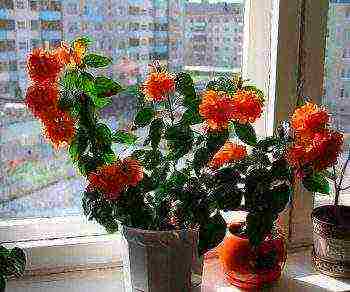
Lighting plays an important role in the cultivation and care of crossandra, which is necessary in sufficient quantities, especially in the winter season.
Watering the crossandra is necessary often and little by little. If the earth lump dries up, the flower reacts immediately: the leaf plates will begin to change color and gradually wither - the root quickly dies in the dried soil.
But this does not mean that you need to water abundantly - it can rot from excessive moisture. It is best to protect the substrate from rapid drying out by pouring sawdust or peat into the pot on the ground. Read also the article: → How to water Dracena at home?
In addition to regular watering, crossandra need spraying... This can be done with a damp sponge or spray bottle. The flower reacts very quickly to wetting the leaves, but if water gets on the buds, they will fall off.
Top dressing of the crossandra: what preparations to use?
The use of fertilizers is one of the important parameters of care: if microelements are not enough, the plant will begin to weaken and hurt. Top dressing is especially important at a time when the plant is blooming: from spring to late summer. Fertilizers need to be applied twice a month - every two weeks. From November to February, crossandras are fed once every 30 days.
There are many types of fertilizers for indoor plants. For crossandra, you can use any of them. Below is information on the most popular drugs, but if the store does not have the listed products, you can buy any other one designed specifically for indoor flowering plants.
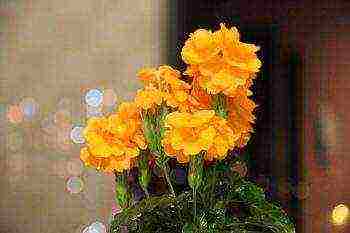
It is better to water the crossandra more often, while the portions for watering should be small so that the soil, along with the roots of the plant, does not rot
| Drug name | Release form and features | Appointment |
| "Fasco" | A liquid containing concentrated nutrients for complete nutrition. | Contributes to the maintenance of the beauty and healthy appearance of plants, their long-term intensive flowering. |
| "Stimulus" | Liquid concentrate with a balanced complex of essential substances and microelements. | For the full development of flowers, increasing their resistance to diseases, stimulating budding. |
| Agricola-Ecogel reviews of gardeners about fertilizer Agricola |
Powdery product. | It is a natural activator and growth stimulant. Promotes root formation, flowering and protection from disease and stress. |
| "Pokon" | Liquid. Differs in improved composition. | Helps maintain the beauty of flowers, improve budding, accelerate the flowering process. |
| "Living Force" | Liquid humic fertilizer. It is an environmentally friendly effective preparation. | Serves as an immunomodulator and biostimulator for flowers. Stimulates active growth and development of flowers. |
Breeding features of the crossandra
You can propagate a perennial in the following ways:
- Seeds. Although this option is more time consuming, it is also more interesting. To get the best result, it is necessary to soak the seeds for 3-4 hours in advance. And plant in a nutritious substrate (coarse sand and peat 1: 1). The container is covered with foil or glass to maintain the required humidity, and kept at a temperature of 22-23 degrees. Watering - as the substrate dries. The first shoots will appear in 2-3 weeks. A month later they dive.
- By cuttings. It is a simpler option, so it is most often used by beginners. Crossandres are propagated by cuttings in the spring - at this time, the segments root best of all. For the procedure, the stems or tops are cut. The necessary soil mixture is prepared in advance. To do this, peat, sod and leafy soil, humus, sand are mixed in equal quantities. Cut cuttings are treated with ash and placed in a pot filled with substrate, and covered with a jar on top. The temperature should be kept within 22-24 degrees. Within a month, cuttings should appear on the segments. Then they are transplanted into separate containers and left at a temperature of about 17-20 degrees.

Crossandra looks great in most interiors and in various styles, however, it requires certain rules in care, without which the plant may not bloom or die
If the roots did not appear, something was done wrong and the procedure must be repeated with new cuttings.
Preparation for transplanting crossandra
Transplant flowers in the spring before they bloom. How often to perform this action depends on the age of the plants themselves: the young need to update the composition every year - they need more useful and nutritious substances for growth. Mature flowers do not grow so quickly, so they are transplanted less often, once every 2-4 years. And this is not just a wish: crossandras do not really like changes - they get used to the new container for a long time, they can begin to bloom much later, shed their leaves, so the transplanting process should be carried out as rarely and carefully as possible.
- Crossandra is transplanted when the roots cover the entire earthen lump and begin to look out from the bottom of the container. This can also be understood by the fact that the flower will stop growing due to the complete depletion of the soil.
- To begin with, prepare a pot. It should be large in size from the previous container by only a couple of centimeters.If you take a large pot, the plant will grow roots in order to completely entangle the substrate with them, then it will use all its forces to build up the ground mass, so that there is something to do with the nutrients drawn from the soil by a powerful root system, but if it starts to bloom, which is rare, it is very weak and short-lived. In addition, such a flower very often disappears due to rotten roots: in a large pot, the substrate remains wet for a long time.
Features of the transplanting process
There is a pot, the plant is well watered - you can start replanting it:
- First, a drainage layer is poured into the container. This can be finely broken red brick, expanded clay, pebbles. The material should occupy a third of the pot.
- Prepare the soil. It should be fertile, porous, and have neutral acidity. To do this, mix leafy soil (2 parts), sod (1 part) and half less humus and sand. Stir the mixture, heat it or pour boiling water over it.
- Disinfect the pot.
- Remove the plant from the old pot.
- Remove diseased or decayed parts of the root.
- Remove the old substrate from the extreme roots.
- Treat the root with a growth stimulant.
- Place the flower in a new container, straightening the roots.
- Fill in the empty spaces with new soil. Gradually and carefully compact it so as not to damage the roots.
- Water the flower and spray the ground part.
- Return the plant to its usual place.
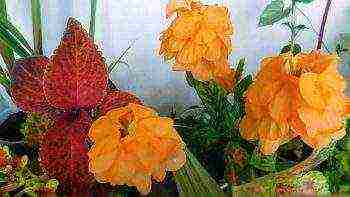
It is better to water the crossandra more often, while the portions for watering should be small so that the soil, along with the roots of the plant, does not rot
Fight against diseases, pests
Improper care often becomes the cause of the disease. Improper watering, too dry air - and the leaves on the flower will begin to curl and dry out. A flower can get sick if, in the summer heat, leave it in the sun without shading. From a draft or hypothermia, leaves may fall off the plant.
The malicious pests of the crossandra are the worm, spider mite, and aphid. They can get on the plant from other flowers or during the summer outdoors. The easiest and fastest way to get rid of pests is by using insecticides for treatment. At the same time, you cannot hesitate, otherwise the plant will die, and the insects will move to other plants in the house. Read also the article: → Ways to combat aphids on a room rose
Popular questions and answers about growing crossandra, as well as caring for it
Question number 1 What is the best way to water the crossandra?
The first rule for caring for crossandra is to prevent the roots and soil from drying out. To avoid this, it is recommended to water the plant frequently, but in small quantities. In this case, drying out can be avoided.
Question number 2 Why do the leaves dry on the crossandra?
In fact, the main reason for the drying and yellowing of the leaves on the crossandra is improper care. This often happens when the soil or root is overdried, which can ultimately lead to the death of the plant. Too dry air can also affect this. So try changing the way you water the plant and humidify the air.
Question number 3 Should crossandra leaves be moistened by spraying with water?
Yes, it is simply necessary to do this. To do this, you can use a special spray bottle or a damp sponge or cloth. It should be noted that it is not recommended that moisture gets on the buds.
Rate the quality of the article. We want to be better for you:
Crossandra (Crossandra infundibuli-formis) - a genus of tropical plants of the Acanthaceae family. Homeland: India, Ceylon.
In nature, it is a deciduous shrub with funnel-shaped flowers of yellow, orange or salmon color, collected in spike-shaped inflorescences up to 15 cm long. It has straight shoots, quite branched, brown or green in color. Leaves of a rich green color with a glossy surface, up to 9 cm long.Crossandra has large flowers in various shades of orange and red, as well as white and yellow. In natural conditions, flowering continues almost all year round. The shrub grows very quickly, and in natural habitats the plant reaches a meter height; we sell undersized cultivars.
Types and varieties of crossandra
In the homeland of the crossandra, in India, there are about 50 species. In home floriculture, such crossandras are known:
- Prickly.
- Nile.
- Guinean.
- Funnel-shaped.
The most widespread in home floriculture is the funnel-shaped crossandra. This shrub reaches a height of 30-50 cm, has opposite glossy dark green leaves with a petiole structure. Shiny leaves with pointed ends and wavy edges look elegant and effective.
The most common variety of this species is Mona Wallhed.... It is characterized by abundant flowering of bright red flowers.
Also popular with flower growers is the Fortuna variety., which is characterized by yellow flowering almost all year round. The inflorescences reach a size of 15 cm, and the bush itself grows no higher than 30 cm. This makes the crossandra even more spectacular and elegant.
Crossandra prickly has a yellow-orange color of flowers... The plant itself is undersized, perennial, with lanceolate leaves.
Nile crossandra has orange-red flowers, its leaves are glossy, elliptical in shape.
Guinea crossandra - a low-growing plant, has lanceolate leaves on short cuttings, and the flowers are lilac in color.
How to care for a thermophilic crossandra at home
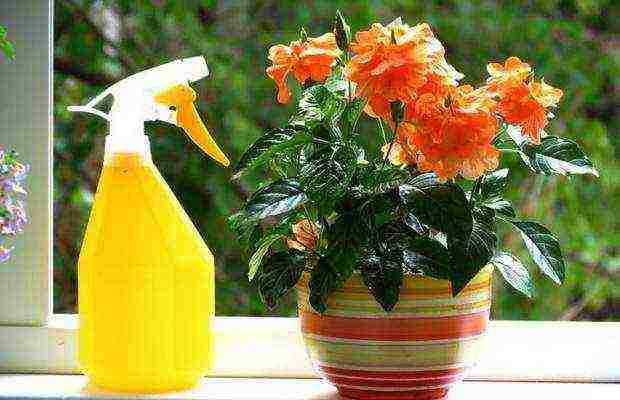

Being an unpretentious plant, crossandra reacts sharply to lack of care and attention. For successful cultivation, the plant needs to create comfortable conditions, which include:
- Good lighting.
- Room temperature of the content.
- Correct watering.
- Wet air.
- Regular feeding.
- Timely transplant.
Indoor herb, the crossandra loves well-lit places. Best location: light to partial shade. The plant does not tolerate direct sunlight, so west and east facing windows are the best choice. If the flower is placed on the south window, then you need to take care of protection from the bright sun. In the shade, crossandra will not develop well and may stop flowering.
Take a look at the photo of what a crossandra indoor flower looks like in the interior of an apartment when you follow simple rules for caring for it:

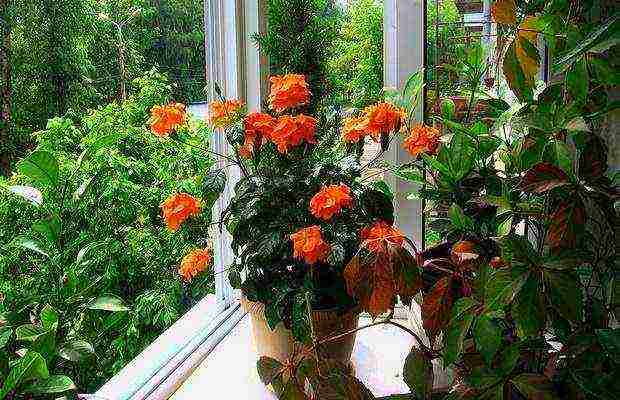

It is important to note that the bush must be periodically turned in different directions towards the light so that it is not one-sided.
The plant loves warmth all year round, therefore it is important to observe the appropriate temperature regime. The optimum temperature in summer is + 22 ... + 24 ° С, in winter - not lower than +18 ° С. In the warm season, the home heat-loving crossandra flower can be placed outdoors, in the garden or on the balcony, finding a place protected from drafts and rain. Sudden changes in temperature can adversely affect the plant, and it will most likely shed its leaves.
When growing a flowering crossandra at home and caring for it, watering and spraying are important components of its successful development and growth. To choose the optimal tactics for watering a plant, it is necessary to take into account the natural conditions of its growth.
The growing season is suspended with the end of the rainy season and the beginning of the dry season. Therefore, watering: during the period of growth and flowering - abundant, 3-4 times a week, from October to February - limited. It is important to feel the difference between slightly damp soil and damp soil.
Water it with soft water at room temperature. The use of rainwater for watering a flower is encouraged, and it is better to stand tap water for a day to reduce the chlorine content in it.
Immediately after watering, it is imperative to drain the liquid from the pallet so that the bottom of the flowerpot is not in the water.If you ignore this recommendation, then there is a risk of getting rotten roots and losing the plant.
When caring for a crossandra flower, it is important to provide the necessary air humidity at home. It should be high - up to 60%. A household humidifier or simple tricks will help maintain the humidity at this level. For example, a flowerpot with a plant is placed on a pallet filled with wet expanded clay.
In addition, you can spray the soil and leaves more often, being careful not to moisten the flowers! The leaves respond very well to spraying, they spread out, and the plant literally comes to life. But funnel-shaped flowers can rot from moisture.
If in winter the plant is placed near a heating radiator, then you can periodically spread wet towels on the radiator so that the air is not too dry. There is another simple trick - it is better to grow a tropical beauty in a ceramic flowerpot, since moisture does not evaporate from it as quickly as from a plastic one.
Transplanting and feeding the crossandra
Before caring for a crossandra bought in a store, it is imperative to transplant it at home. This is necessary because the soil in which the flowers are sold is transportable and does not meet the plant's requirements. Drainage must be placed at the bottom of the pot, it can be small expanded clay or pebbles. Since the plant will be watered frequently and abundantly, any water retention can be detrimental to the crossandra.
For planting, you need to take nutritious light soil. It must and consist of equal parts:
- Leafy land.
- Sod.
- Sand.
- Humus.
- Peat.
Young crossandra need an annual transplant, and when the plant gets stronger, its root system is developed and the crown is formed, it will be enough to transplant it every few years. The transplant should be carried out in February, when the flowering has not yet begun.
In caring for an indoor flower with a crossandra, regular feeding is as mandatory as watering. To do this, you can use any complex fertilizer for flowering home perennials, for example "Plantafol" or "Master Color".
These are mineral fertilizers, and organic fertilizers should be used carefully, infrequently and in small dosages. Top dressing is done every 14 days from March to August. However, if flowering continues, then feeding should not be stopped. Around mid-November, it is advisable to reduce the watering and fertilization of the plant and give it a rest.
Pruning crossandra shoots: how to prune a houseplant
After the end of the flowering period, the shoots are trimmed, the temperature of the content decreases slightly and the dormant period begins. Before pruning a homemade crossander, you need to determine what appearance the plant should have, arm yourself with a pruner and cut off long cuttings. In addition, you need to remove all dried branches, leaves and faded inflorescences.
The dormant period will last until early February, and then again you need to trim the shoots of the cross by about a third of their length and arrange a beautiful crown. Along with shortening long shoots, they are also pinched. This action will give the plant the opportunity to release lateral shoots, and the ornamental shrub will become lush and elegant.
Watch a video about caring for a crossandra, which clearly shows all the steps for transplanting, pruning and forming a bush:
A method of propagation of a crossandra flower at home by cuttings
There are two ways to propagate indoor crossandra:
- Cuttings.
- Seeds.
It is logical that having a flowering plant in the collection, it is better to propagate it by cuttings. This method is much simpler, more efficient and more reliable than growing from seed. In addition, the reproduction of the indoor flower of the crossandra by cuttings guarantees that there will not be a loss of traits of a particular species, and as a result, the young plant will exactly repeat the characteristics of the mother plant.
Breeding with apical or stem cuttings will require patience and some skill. The optimal rooting time is in February, at a soil temperature of + 20 ... + 25 ° С. For reproduction of crossandra, you need to prepare cuttings 10-15 cm long and place them in water.
You can enter into the liquid a small amount of a growth stimulant, for example, "Kornevin". When the roots are 1.5 cm long, you can transfer the cuttings to separate pots. The composition of the soil should be the same as for transplanting the plant.

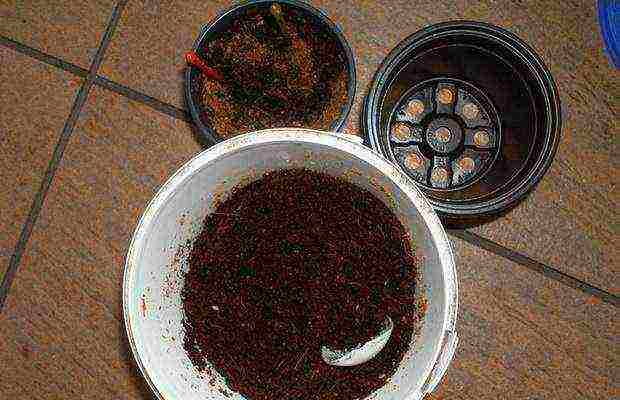


As a rule, there are no problems with the survival rate of the crossandra when propagated by cuttings at home. The plant adapts quite quickly, and care for it must be the same as for an adult flower. In young plants, pinch the shoots more often to stimulate tillering.
How to propagate decorative crossandra by seeds at home
When propagating by seeds, it must be borne in mind that they are characterized by low germination. First, the seeds need to be soaked in warm water for several hours. In the meantime, a prepared substrate should be poured into the seedling container: a flower soil mixture with an admixture of polystyrene chips. The soil must be moistened and loosened well.
Next, surface sowing of seeds is carried out: they do not need to be deepened into the substrate and covered from above. The soil should be warm, and the container should be covered with plastic or glass to protect it from drafts and cold air.
When a decorative crossandra is grown from seeds at home, it is important to maintain the temperature of the soil and the environment at + 25 ° C and ensure the ingress of light.
Depending on the quality of the seed and the variety of the plant, the germination time of the seeds can vary from 14 days to 2 months.
After about 1.5 months, when the seedlings are strong, they can be moved to separate pots. The soil should be composed of peat and sand in equal parts. It should be noted that young seedlings, although often bloom in the year of sowing, do not give such abundant flowering as adult plants.
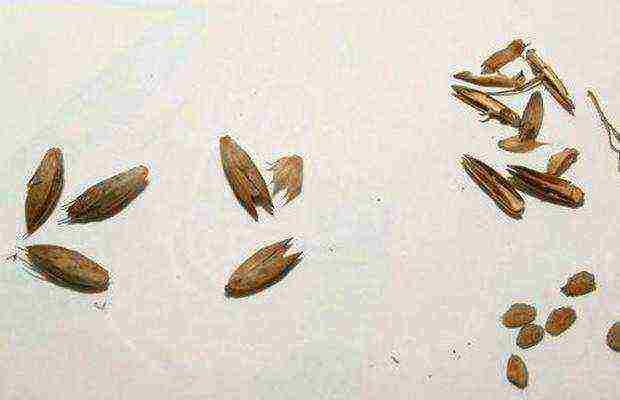
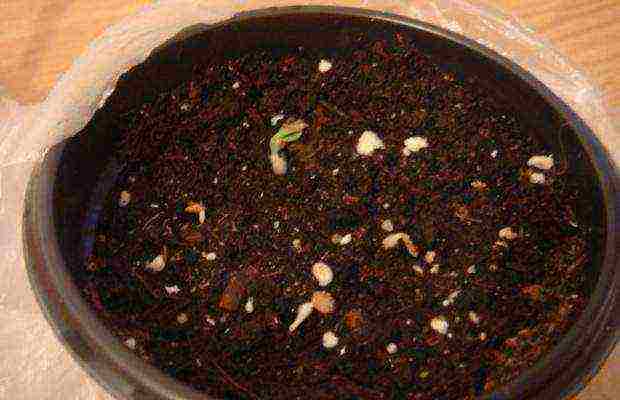
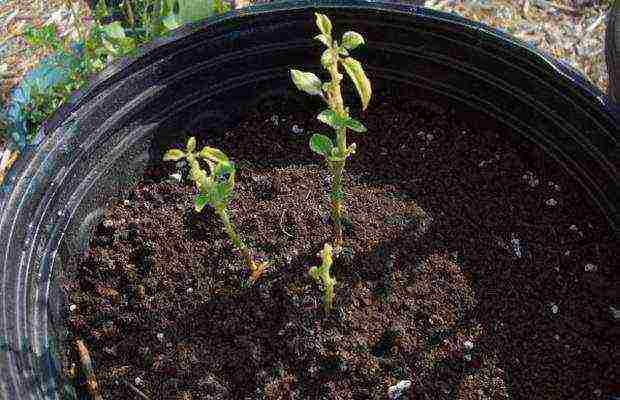
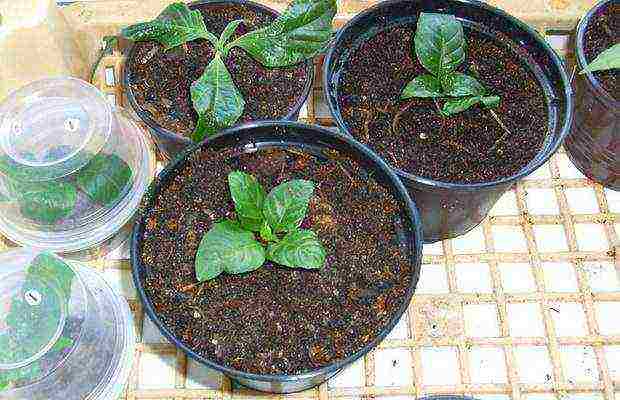
The main diseases and pests of crossandra
The main problems faced by owners of crossandra are such pests and diseases:
Aphid.
Spider mite.
Scratch.
Falling and rolling of leaves.
Leaf mold.
Lack of flowering.
- If the leaves of a plant turn yellow or fall off, then this may be due to drying out of the roots. Also, a sharp drop in temperature, direct sunlight and drafts can become the cause of such a disease of thermophilic crossandra. Drying of the tips of the leaves can also indicate dry indoor air.
- If the plant is overly moisturized, there is a risk of developing leaf mold. It manifests itself as brown spots over the entire surface of the leaf plate and the affected leaves gradually dry out. If a disease is detected, treatment with a systemic fungicide is necessary, and the damaged leaves must be removed.
- The main pests parasitizing on the crossandra: aphids, worms and spider mites. They can move to a flower from other houseplants and destroy it. It is not difficult to detect parasites by their characteristic features.
- Aphids are well visualized on plants: their tops are deformed, leaves are twisted and they are covered with sticky secretions. The parts of the plant most populated by the pest must be removed, and the bush itself must be bathed in the shower and the leaves must be washed with a solution of laundry soap.
- The worm secretes white, sticky mucus, which gives the impression that the plant has been sprinkled with flour. The pest settles in leaf axils, in buds and on young shoots. To destroy the parasite, you can resort to the folk method of struggle with the help of a soap-alcohol solution. You need to take 1 teaspoon of grated laundry soap and 3 tbsp. tablespoons of alcohol or vodka per 1 liter of water. The plant is sprayed with this solution every 4 days, being careful not to get on the soil.
- The spider mite feeds on the cell sap of the plant. It can be found by turning the leaf over, where the parasite colonies attach along the veins. A thin cobweb can be seen on infected plants. The plant must be treated with a solution of laundry soap and washed with warm water. Both the flowerpot, the pallet and the window sill must be carefully processed.
In the fight against all of these pests, you can use purchased systemic insecticides, such as "Phosphamide".
Reasons why crossandra does not bloom
Often, flower growers have a question why crossandra does not bloom at all or does not bloom abundantly enough. The reasons may be as follows:
- Not enough light.
- No trimming done.
- The plant needs to be renewed.
- A very young seedling.
Based on the listed points, measures to eliminate this problem are also understandable. If the crossandra does not bloom for a long time due to a lack of light, then you need to rearrange it or highlight it additionally. Shoots need to be pruned and pinched in a timely manner to stimulate flowering. If the plant is more than 4 years old, then it needs replanting or updating.
The name of the plant is derived from two Greek words krossos - fringe and andr - masculine. Crossandra has early and long flowering (spring-autumn), which is ideal for indoor cultivation. To date, there are about 50 species of flowers that are found in natural conditions in the tropics of Africa, Arabia, the island of Madagascar.
Indoor flower crossandra belongs to the Acanthus family. It is a deciduous shrub about a meter high. India is considered to be its homeland. Almost all Indian women grow this flower. Go to the temple, they are sure to decorate their hair with crossandra and jasmine flowers.
Crossandra grows very quickly. She has erect, branched shoots, green or brown-purple in color. Frequent pinching promotes branching. Leaves are glossy, bright green in color, reaching a length of 3-9 cm. Red, yellow, orange, apricot flowers gather in spike-shaped inflorescences with edges. The peduncle reaches a length of 15 cm.
How to care for crossandra at home

Crossandra care and cultivation at home photo
Breeding work on the development of new varieties allows you to care for the crossandra flower at home without much difficulty. only sometimes problems can arise that can be easily eliminated with the right approach.
Crossandra transplant after purchase
In flower shops, the plant is treated with a special solution to provide an attractive look. This promotes intense flowering and a healthy appearance, but strong stimulation of the flower leads to depletion and after a while after purchase, it may look worse. If the crossandra does not bloom after purchase, immediately transplant it into a new flowerpot, or do it at the end of flowering.
Transplanting a flower is not difficult:
- Choose a container slightly larger than the existing container, lay a drainage layer of fine pebbles or expanded clay on the bottom.
- Water the flower and let stand until the earthy coma is completely moistened (4-6 hours).
- Free the plant from the pot by gently lifting the pot from the roots.
- Plant the flower in a new pot, taking care not to disturb the roots, fill the voids with nutritious soil and press lightly with your fingers.
- Water sparingly and drain any excess water from the sump.
Soil and fertilizing for crossandra
You need loose soil. It can be a mixture of their peat, leaf and sod land in equal proportions with the addition of about 10% sand, you can add a little clay to have a positive effect on the root system. Be sure to lay a good drainage layer.
During the flowering period, it is recommended to apply organic mineral fertilizers every week. During the absence of flowering, it is not necessary to feed, this can promote active growth of leaves and slow down the onset of flowering.
Growing conditions for crossandra

Crossandra fortune home care photo
Watering
Never fill a flower if you don't want it to die! Crossandra is sensitive to watering and lighting. Growth and flowering directly depend on them. In summer, water as soon as the topsoil dries up. Maintains balance: do not overfill or dry out. Use settled water at room temperature. Water sparingly in winter. When there are no flowers, watering is reduced too. Water about once every two weeks.
A resident of the tropics will also need regular humidification. Any methods are suitable: spraying, special devices, neighborhood with an aquarium, placing on pallets with expanded clay, moss. The hotter it is, the more often you need to spray the leaves, avoiding water getting on the opened flowers.
Lighting
For abundant long-term flowering, bright diffused lighting is necessary. Direct sunlight is a dangerous burn for delicate buds and leaves. Insufficient lighting can halt flowering. In winter, expose the flower to the southern windowsills. You can also use artificial lighting.
Temperature
The temperature regime should be close to the tropical one. In winter, the air temperature in the premises should be about 18 ° C, a temporary decrease to a maximum of 16 ° C is allowed. It tolerates summer heat well, the maximum permissible temperatures are 27-28 ° C, the optimal one is 21 ° C.
Cropping the crossandra
The plant can and should be pruned, forming a crown to your liking. Remember, pruning is best done after flowering to avoid weakening the plant or cutting off the flower buds. The faded crossandra can be cut even drastically if you want to rejuvenate the bush: the trunk will release new young branches. In general, they cut out all the excess, thickening branches or growing unevenly, shorten them to the desired length. But it is advisable not to get carried away, leaving about two-thirds of the length of the shoots.
Growing crossandra from seeds at home
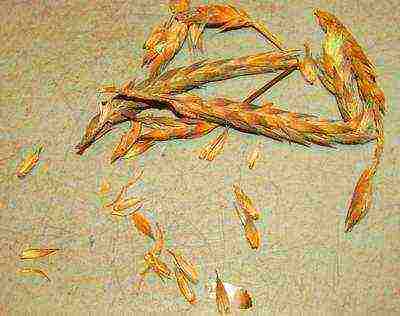
Crossandra seed reproduction Photo of seed
Reproduction is possible by seeds and cuttings.
How to propagate crossandra by seeds? Despite the rather great difficulties in getting seeds, you can still find them on sale and then you just have to follow simple agricultural techniques. If you have harvested homemade seeds, make sure they are not from a hybrid so that the work does not disappoint: hybrids do not transfer their properties to new plants obtained from seeds. In this case, you need to resort to grafting, more on that below.
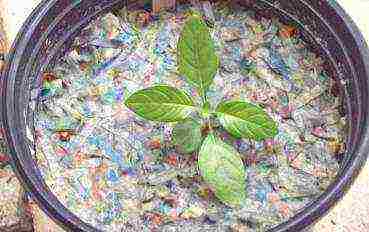
Crossandra from seed photos of seedlings
- Soak the seeds for 6-8 hours in water to increase germination and speed up germination. To facilitate sowing, the seeds can be dried until flowable.
- The soil should be composed of equal proportions of coarse sand and peat.
- Moisten the soil, cover the seeds shallowly, cover the crops with foil and maintain the temperature at 22-24 ° C.
- Provide high humidity, preferably cover the container with foil for a while and do not forget to ventilate daily.
- The first shoots will appear in 2-3 weeks. Water sparingly to prevent young stems from rotting.
- Dive young plants in separate pots a month after germination, when the first true leaves appear.
- After another month, transfer together with the earthen clod into the already permanent pots.
Propagation of crossandra by cuttings

Rooting cuttings of a crossandra photo
How to root cuttings of crossandra? The best time for rooting cuttings is spring, but cuttings are also possible in summer.
- Prepare cuttings 10-15 cm long.
- For rooting, use a mixture of equal proportions of leaf, turf, peat and humus, you can add a little sand.
- The cuttings take root within 3-4 weeks.
- Maintain a temperature of 20-22 ° C at all times.
- To make rooting faster, you can cover with foil, a transparent plastic cup, or heat the soil from below.
- Rooted cuttings are transplanted into large pots with suitable soil and mandatory drainage at the bottom of the pot.
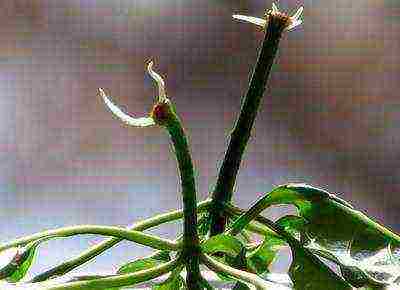
Crossandra cuttings rooted in water photo
Crossandra cuttings root well in water. Before you start germinating them, soak them in the root solution for several hours. And then put it in the water until the roots appear. Cuttings with roots are planted immediately in permanent pots.
Diseases and pests of crossandra
The beautiful leaves of the crossandra are very often affected by various molds. When this happens, reduce watering, remove the affected leaves, treat the plant with a fungicide.
The leaves of the crossandra turn black below
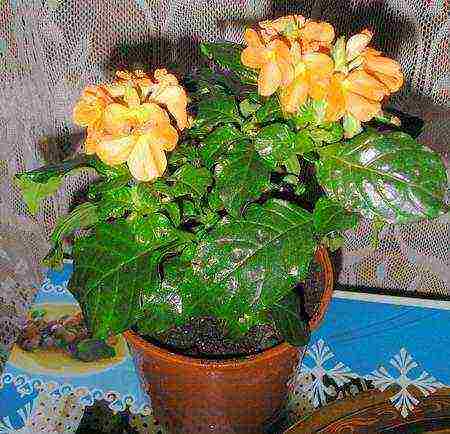
Why do crossandra's leaves turn black?
The defeat of the plant with rot must be urgently treated, since the disease is spreading quickly. You will have to cut off all the healthy tops and plant them like cuttings. The remaining bush is removed from the ground, the soil is washed off, the roots are carefully examined: all the affected areas are cut off. If rot also manifests itself on the trunk, it is shortened to healthy tissue, and planted again. The planted plant must be treated with a fungicide (for example, phytosporin).
If insects appear
Pests rarely affect the plant. This happens mainly from low humidity - you must always keep it at optimum. Leaves can attack spider mites and aphids. In case of minor lesions, insects are washed off with soapy water, avoiding water getting into the pot. If you can't get rid of the pests, treat the plant with an insecticide.
Improper care
With a lack of moisture or drying out of the soil, the leaves of the crossandra begin to wither and fall off. Leaves can also fall off from sudden temperature changes. Watering (no frills!) And regular spraying will help revive the plant.
Due to a lack of light, flowering is less abundant or may be absent altogether - provide adequate lighting.
You need to transplant the crossandra every 3-4 years.
Types of crossandra with photo and description
Funnel-shaped crossandra Crossandra Infundibuliformis
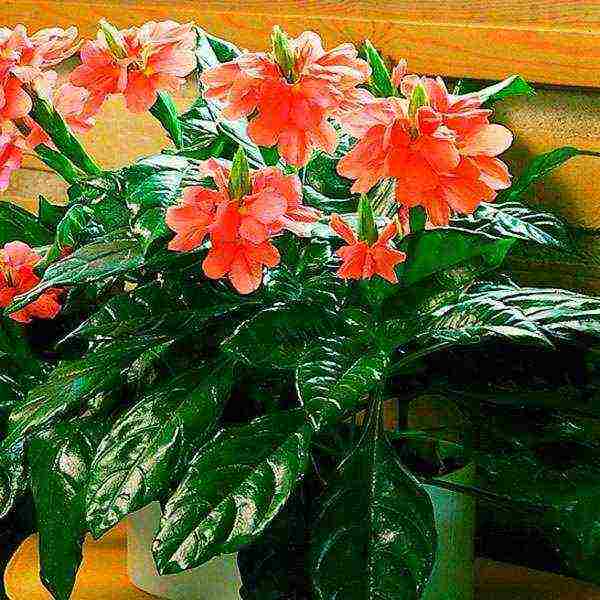
Funnel-shaped crossandra Crossandra Infundibuliformis photo
Bush 30-50 cm high. Flowers 2.5 cm in diameter are bright orange, each flower has a large pubescent bracts.
Crossandra prickly Crossandra pungens
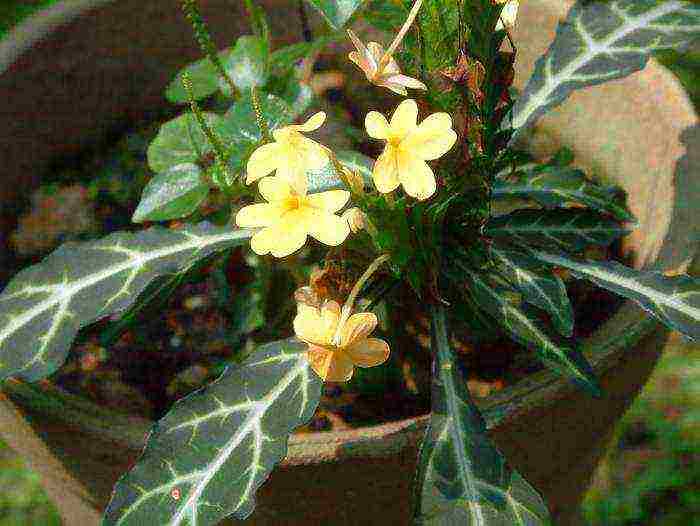
Crossandra barbeda Crossandra pungens photo
Herbaceous perennial plant. The leaves are oblong, the lower leaves reach a length of about 12 cm, and the upper ones are only 2.5 cm long. Abundant flowering. The flowers are small, yellow-orange in color, gather in dense spike-shaped inflorescences.
Crossandra nilotica or nylotika Crossandra nilotica

Crossandra nile or nylotika Crossandra nilotica photo
Also called red. A semi-shrub about half a meter high. Leaves are dense, glossy, dark green. Flowers are five-lobed, tubular, gather in short inflorescences at the tops, have a brick-red or salmon-pink hue.
Crossandra Guineensis
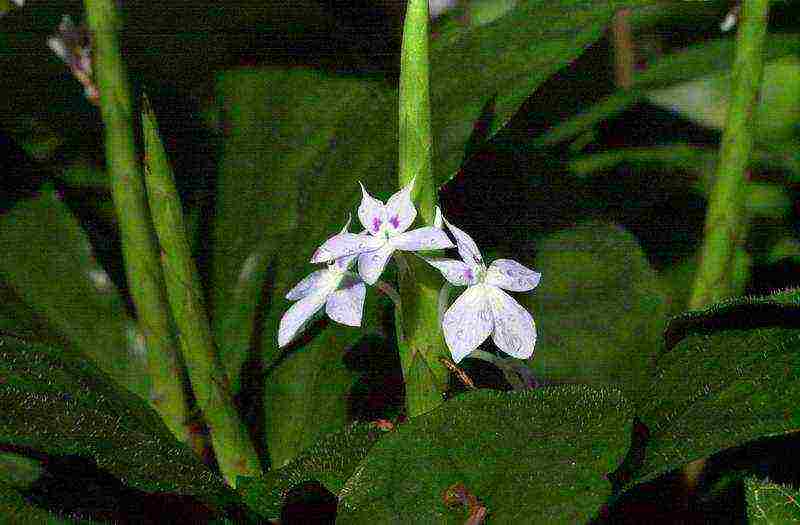
Crossandra Guinea Crossandra Guineensis photo
The plant is about 12-20 cm high. The trunk is covered with dense short down. The leaves are short petiolate, the leaf surface is colored green, and the lower surface is covered with wine-red veins. Inflorescences are narrow, spike-shaped, reaching a height of 5-15 cm. Flowers with a diameter of about 2 cm, painted in a delicate pale lilac or white.
Knowledge and adherence to fairly simple rules for caring for a crossandra will allow you to create a unique flower arrangement at home.
Crossandra belongs to the Acanthus family. These are compact shrubs with impressive inflorescences of bright yellow, red or orange hues, which are happily grown by flower growers when they care at home.
The plant is widespread in the warm tropics of Africa and India. Under natural conditions, the plant can exceed a meter in height, and at home it is much lower. The foliage of the plant is of a dark olive shade. The shape is an oblong oval. The surface is glossy, rarely hairy. The plant pleases with long and abundant flowering.
Varieties and types
Crossandra Fortune plant height can reach about 30 cm. The foliage is green. Inflorescences are orange in color and up to 15 cm in height. This species always pleases with flowering longer. Orange crossandra supports buds for a long time.
Blue crossandra its second name is blue ice. The inflorescences of this variety are blue. The leaves are dark green in color.
Crossandra variegated the species is more demanding on lighting than other species. Orange-colored inflorescences. The foliage is bright green with light stripes along the leaves.
Crossandra red, it is a bush, reaching a height of 60 cm. The leaf is dark rich green with a smooth surface and an oblong length. The inflorescences are pink or dark scarlet.
Wavy crossandra quite demanding individual in cultivation. The foliage is dense, dense, green. The inflorescences have a scarlet or orange tint.
Crossandra "Green Ice" this is a rare specimen. This species has interesting inflorescences of a turquoise hue. The foliage is glossy, green.
to the table of contents
Crossandra home care
The lighting for the plant is preferably bright, but diffuse. Placed indoors should be on the west or east side of the room. If the plant is likely to be exposed to direct sunlight, then it is better to create a shade. With a lack of light rays, the plant blooms worse.
The air temperature in the room during the warm period should correspond to about 25 degrees, and in the winter not lower than 18 degrees.
The flower prefers a good spray from a spray bottle. In this case, it is impossible for moisture to get on the inflorescences, sprinkle only on the leaves. In hot weather, spray several times every day.
Watering the plant should be done as needed, after the top layer of the earth has dried. Water for irrigation must be settled. The water temperature should be at room temperature.
Fertilizers for crossandra are needed every seven days. You need to feed with a complex fertilizer for flowering indoor plants.
The soil for the plant is preferable light and nutritious. The composition should include humus, coarse sand and peat in equal parts.
to the table of contents
Crossandra transplant
A transplant for young individuals is performed every year, and adult plants, every three years. The transplant should be done in early spring.
to the table of contents
Cropping the crossandra
After each flowering, the shoots are cut to one third of the total length.
to the table of contents
Seed crossandra
Reproduction of crossandra from seeds is a rare breeding method, due to non-annual fruiting. The seeds are sown into the soil from peat soil and coarse sand. It is necessary to maintain a temperature of 23 degrees and periodically spray the soil.
Seedlings appear a few weeks after sowing. After the appearance of several pairs of leaves, the seedlings need to be planted in small disposable glasses. After that, the plant must be pinched. For seedlings to release additional shoots. After this procedure, the seedlings need to be transplanted in a container several centimeters larger than the previous one.
to the table of contents
Crossandra propagation by cuttings in water
To do this, take a ten centimeter stalk, separate the lower leaves from it and place it in a container with water. After that, we wait for the roots to appear and plant them in the ground. And we give the plant the opportunity to adapt. We provide care as for an adult plant.
to the table of contents
Diseases and pests
- Why do the leaves of the crossandra turn red - the reason for this is the direct hit of sunlight on the leaves. This accelerates the aging process of the leaves and their further dropping. Therefore, it is better to save the plant from direct sun exposure.
- Why do the leaves of the crossandra turn black - the reason is the cold content. The plant does not tolerate a drop in temperature below 18 degrees.It is also necessary to avoid drafts and moisture stagnation.
- Why crossandra dropped the leaves - most likely the reason was the drying out of the soil.
- The leaves of the crossandra dry out - a lack of spraying of the plant and dry air in the room. It is necessary to provide the plant with good moisture and spraying.
- Why crossandra does not bloom - there may be little lighting, or incorrect pruning of the plant after flowering and therefore new cobs for buds are poorly formed. Also, the lack of flowering may be due to the age of the plant. If the plant is already more than 4 years old, then the abundance of flowering comes to a decrease.
- Also, the plant can be affected by aphids and mealy worms. To remove it, the plant should be treated with an appropriate insecticide.
to the table of contents


